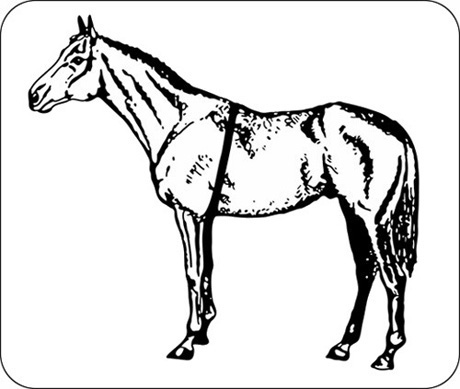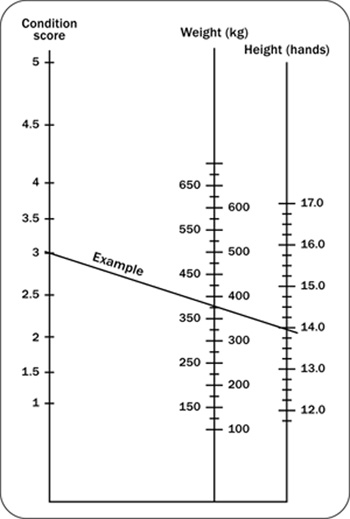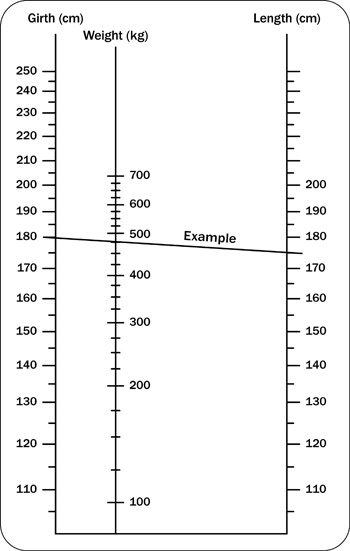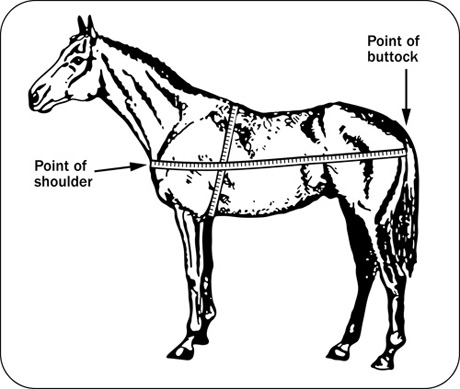Estimating body weight for horses
Learn how to determine your horse’s weight.
ISSN 1198-712X, Published November 2010
Importance of body weight in horses
Health and management
A horse's weight can be an important health indicator. Knowing how much a horse weighs and whether it is currently gaining or l osing weight, can help identify health issues. A horse may be under or over its optimal weight for a variety of reasons.
Low body weight in a horse can be caused by:
- health problems (disease or hormone imbalance)
- old age
- parasites
- dental disease or discomfort
- overwork
- unbalanced diet
- insufficient feed (sometimes caused by low pecking order in the herd)
- genetics
Excess body weight in a horse can be caused by:
- health problems (disease or hormone imbalance)
- insufficient exercise
- unbalanced diet
- over-feeding
- genetics
Calculating dosages
Dosages for de-wormers and antibiotics are calculated using the horse's weight. Incorrect weight estimation may result in over-dosing or under-dosing the animal.
Over-dosing medicinal products may cause toxicity and colic or other serious complications, including death. Under-dosing will not produce the desired effects and, in the case of antibiotics, may lead to antibiotic resistance.
Determining a horse's weight
Weigh scale
Using a weigh scale is the most accurate way to determine a horse's weight. Always weigh the horse under the same conditions - for example, 2 hours after it's been fed and watered - to reduce misleading fluctuations in the readings.
Horses can also be weighed at weigh stations such as at grain elevators and landfill sites, but this is often not practical. The other methods outlined below provide a body weight estimation that will be accurate and safe enough for determining feed quantities and dosages of medicines or de-wormers.
Weight tape
A weight tape is a simple and effective way to estimate a horse's weight at a fraction of the cost of a weigh scale and with minimal effort (Figure 1). Weight tapes are readily available in most tack and feed shops.

Wrap the tape around the girth of the horse, directly behind the elbow, overlapping the ends of the tape and read the resultant weight. Take the reading with the tape snugly in place, when the horse has exhaled.
Tape accuracy is dependent on the user, size of the withers, breed and age. Tapes are not effective on miniature horses and foals.
Girth measurements
Use Table 1 (taken from Lon Lewis's Feeding and Care of the Horse) to help estimate the weight of a horse by its girth measurement when a weight tape is not available.
Girth and body length measurements
Using the girth measurement together with the body length measurement in the following calculation may produce a slightly more accurate measurement than using a weight tape.
Adult horses:
Weight (kg) = [(girth measurement in cm)2 x (length measurement in cm)] ÷ 11,900
Foals 0-60 days:
Weight (kg) = [girth measurement in inches - 25] ÷ 0.07
| Girth Length (inches) | Girth length (cm) | Weight (lbs) | Weight (kg) |
|---|---|---|---|
| 30.0 | 76 | 100 | 45.5 |
| 40.0 | 102 | 200 | 91.0 |
| 45.5 | 116 | 300 | 136.5 |
| 50.5 | 128 | 400 | 182.0 |
| 55.0 | 140 | 500 | 227.0 |
| 58.5 | 148 | 600 | 273.0 |
| 61.5 | 156 | 700 | 318.0 |
| 64.5 | 164 | 800 | 364.0 |
| 67.5 | 171 | 900 | 409.0 |
| 70.5 | 178 | 1000 | 455.0 |
| 73.0 | 185 | 1100 | 500.0 |
| 75.5 | 192 | 1200 | 545.0 |
| 77.5 | 197 | 1300 | 591.0 |
Nomograms
Nomograms are available for estimating a horse's body weight. The two shown here were developed by C.L. Carroll and P.J. Huntington.
The nomogram in Figure 2 relies on the assessment of body condition score and height at the withers. It gives good results for all but horses in racing condition. The more accurately height and condition score are established, the better the weight assessment will be. Ensure that the horse is standing squarely on level ground, is relaxed and has the head in the normal position before measuring its height.

Make allowance for the thickness of the shoes. To calculate, run a straight line on the chart between the horse's known body condition score and height, then read its weight on the centre axis. In the example, a 14-hand pony, scoring 3 points on the condition scoring chart, shows an estimated body weight of 375 kg.

The nomogram in Figure 3 relates measurement around the girth to length, is slightly more accurate and is the method to be used for racehorses in full work. The girth measurement is taken immediately behind the elbow after the horse has exhaled. Length is taken from the point of the shoulder to the point of buttocks (Figure 4). To calculate, run the straight line on the chart between the known girth and length. In the example, a horse with a girth of 180 cm and a length of 175 cm shows an estimated body weight of 475 kg.
The approaches in this Factsheet provide several options for measuring and estimating the weight of horses, which is a fundamental aspect of equine husbandry and health management.

References
Carroll, C.L., and P.J. Huntington (1988). Body Condition Scoring and Weight Estimation of Horses. Equine Veterinary Journal 20 (1), 41-45.
Henneke, D.R., G.D. Potter, J.L. Kreider, and B.F. Yeates (1983). Relationship Between Condition Score, Physical Measurement and Body Fat Percentage in Mares. Equine Veterinary Journal 15, 371-372.